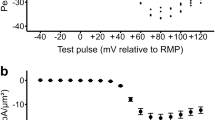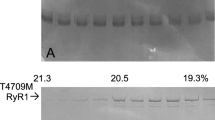Abstract
RECENT advances in understanding the molecular basis of human X-linked muscular dystrophies (for a review, see ref. 1) have come from the identification of dystrophin, a cytoskeletal protein associated with the surface membrane2–4. Although there is little or virtually no dystrophin in affected individuals5,6, it is not known how this causes muscle degeneration. One possibility is that the membrane of dystrophic muscle is weakened and becomes leaky to Ca2+ (refs 7–9). In muscle from mdx mice, an animal model of the human disease10, intracellular Ca2+ is elevated and associated with a high rate of protein degradation11. The possibility that a lack of dystrophin alters the resting permeability of skeletal muscle to Ca2+ prompted us to compare Ca2+permeable ionic channels in muscle cells from normal and mdx mice. We now show that recordings of single-channel activity from mdx myotubes are dominated by the presence of Ca2+-permeable mechano-trans-ducing ion channels. Like similar channels in normal skeletal muscle, they are rarely open at rest, but open when the membrane is stretched by applying suction to the electrode12–14. Other channels in mdx myotubes, however, are often open for extended periods of time at rest and close when suction is applied to the electrode. The results show a novel type of mechano-transducing ion channel in mdx myotubes that could provide a pathway for Ca2+ to leak into the cell.
This is a preview of subscription content, access via your institution
Access options
Subscribe to this journal
Receive 51 print issues and online access
$199.00 per year
only $3.90 per issue
Buy this article
- Purchase on Springer Link
- Instant access to full article PDF
Prices may be subject to local taxes which are calculated during checkout
Similar content being viewed by others
References
Hoffman, E. P. & Kunkel, L. M. Neuron 2, 1019–1029 (1989).
Knudson, C. M. Hoffman, E. P., Kahl, S. D., Kunkel, L. & Campbell, K. P. J. biol. Chem. 263, 8480–8484 (1988).
Watkins, S. C., Hoffman, E. P., Slayter, H. S. & Kunkel, L. M. Nature 333, 863–866 (1988).
Campbell, K. P. & Kahl, S. D. Nature 338, 259–262 (1989).
Webster, C., Silberstein, L., Hays, A. P. & Blau, H. M. Cell 52, 503–513 (1988).
Bonilla, E. et al. Cell 54, 447–452 (1988).
Bodensteiner, J. B. & Engel, A. G. Neurology 28, 439–446 (1978).
Fingerman, E., Campisi, J. & Pardee, A. B. Proc. natn. Acad. Sci. U.S.A. 81, 7617–7621 (1984).
Mongini, T. et al. Neurology 38, 476–480 (1988).
Bulfield, G., Siller, W. G., Wight, P. A. L. & Moore, K. J. Proc. natn. Acad. Sci. U.S.A. 81, 1189–1192 (1984).
Turner, P. R., Westwood, T., Regen, C. M. Steinhardt, R. A. Nature 335, 735–738 (1988).
Brehm, P., Kullberg, R. & Moody-Corbett, F. J. Physiol. 350, 631–648 (1984).
Guharay, F. & Sachs, F. J. Physiol. 352, 685–701 (1984).
Franco, A. Jr & Lansman, J. B. J. Physiol. (in the press).
Morris, C. E. & Sigurdson, W. J. Science 243, 807–809 (1989).
Adams, D. J., Dwyer, T. M. & Hille, B. J. gen. Physiol. 75, 493–510 (1980).
Leonard, J. P. & Salpeter, M. M. J. Cell Biol. 82, 811–819 (1979).
Cooper, B. J. & Hamill, O. P. Soc. Neurosci. (Abstr.) 15, 412.5 (1989).
Hamill, O. P., Marty, A., Neher, E., Sakmann, B. & Sigworth, F. J. Pflugers Arch. ges. Physiol. 391, 85–100 (1981).
Author information
Authors and Affiliations
Rights and permissions
About this article
Cite this article
Franco , A., Lansman, J. Calcium entry through stretch-inactivated ion channels in mdx myotubes. Nature 344, 670–673 (1990). https://doi.org/10.1038/344670a0
Received:
Accepted:
Issue Date:
DOI: https://doi.org/10.1038/344670a0
This article is cited by
-
The emerging role of Piezo1 channels in skeletal muscle physiology
Biophysical Reviews (2023)
-
Electrocardiographic features of children with Duchenne muscular dystrophy
Orphanet Journal of Rare Diseases (2022)
-
Multiple LEDT wavelengths modulate the Akt signaling pathways and attenuate pathological events in mdx dystrophic muscle cells
Photochemical & Photobiological Sciences (2022)
-
Biochemical and Functional Interplay Between Ion Channels and the Components of the Dystrophin-Associated Glycoprotein Complex
The Journal of Membrane Biology (2018)
-
Mitochondria mediate cell membrane repair and contribute to Duchenne muscular dystrophy
Cell Death & Differentiation (2017)
Comments
By submitting a comment you agree to abide by our Terms and Community Guidelines. If you find something abusive or that does not comply with our terms or guidelines please flag it as inappropriate.



